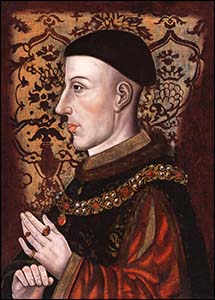
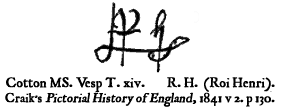
HENRY V, King of England, son of King Henry IV by Mary de Bohun, was born at Monmouth, in August 1387. On his father's exile in 1398, Richard II took the boy into his own charge, and treated him kindly.
Next year the Lancastrian revolution forced Henry into precocious prominence as heir to the throne. From October 1400 the administration of Wales was conducted in his name; less than three years later he was in actual command of the English forces and fought against the Perciesat Shrewsbury. The Welsh revolt absorbed his energies till 1408. Then through the king's ill-health he began to take a wider share in politics. From January 1410, helped by his unclesHenry Beaufort and Thomas Beaufort, he had practical control of the government. Both in foreign and domestic policy he differed from the king, who in November 1411 discharged the prince from the council.
The quarrel of father and son was political only, though it is probable that the Beauforts had discussed the abdication of King Henry IV, and their opponents certainly endeavoured to defame the prince. It may be that to political enmity the tradition of Henry's riotous youth, immortalized by Shakespeare, is partly due. To that tradition Henry's strenuous life in war and politics is a sufficient general contradiction. The most famous incident, his quarrel with the chief justice, has no contemporary authority and was first related by Sir Thomas Elyot in 1531. The story of Falstaff originated partly in Henry's early friendship for Oldcastle. That friendship, and the prince's political opposition to Archbishop Arundel, perhaps encouraged Lollard hopes. If so, their disappointment may account for the statements of ecclesiastical writers, like Walsingham, that Henry on becoming king was changed suddenly into a new man.
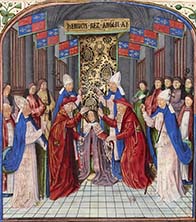 Henry succeeded his father on the 20th of March 1413. With no past to embarrass him, and with no dangerous rivals, his practical experience had full scope. He had to deal with three main problems — the restoration of domestic peace, the healing of schism in the Church and the recovery of English prestige in Europe. Henry grasped them all together, and gradually built upon them a yet wider policy. From the first he made it clear that he would rule England as the head of a united nation, and that past differences were to be forgotten.Richard II was honourably reinterred; the youngMortimer was taken into favour; the heirs of those who had suffered in the last reign were restored gradually to their titles and estates. With Oldcastle Henry used his personal influence in vain, and the gravest domestic danger was Lollard discontent. But the king's firmness nipped the movement in the bud (Jan. 1414), and made his own position as ruler secure. Save for the abortive Scrope and Cambridge plot in favour of Mortimer in July 1415, the rest of his reign was free from serious trouble at home. Henry could now turn his attention to foreign affairs.
Henry succeeded his father on the 20th of March 1413. With no past to embarrass him, and with no dangerous rivals, his practical experience had full scope. He had to deal with three main problems — the restoration of domestic peace, the healing of schism in the Church and the recovery of English prestige in Europe. Henry grasped them all together, and gradually built upon them a yet wider policy. From the first he made it clear that he would rule England as the head of a united nation, and that past differences were to be forgotten.Richard II was honourably reinterred; the youngMortimer was taken into favour; the heirs of those who had suffered in the last reign were restored gradually to their titles and estates. With Oldcastle Henry used his personal influence in vain, and the gravest domestic danger was Lollard discontent. But the king's firmness nipped the movement in the bud (Jan. 1414), and made his own position as ruler secure. Save for the abortive Scrope and Cambridge plot in favour of Mortimer in July 1415, the rest of his reign was free from serious trouble at home. Henry could now turn his attention to foreign affairs.
A writer of the next generation was the first to allege that Henry was encouraged by ecclesiastical statesmen to enter on the French war as a means of diverting attention from home troubles. For this story there is no foundation. The restoration of domestic peace was the king's first care, and until it was assured he could not embark on any wider enterprise abroad. Nor was that enterprise one of idle conquest. Old commercial disputes and the support which the French had lent to Glendower gave a sufficient excuse for war, whilst the disordered state of France afforded no security for peace. Henry may have regarded the assertion of his own claims as part of his kingly duty, but in any case a permanent settlement of the national quarrel was essential to the success of his world policy.
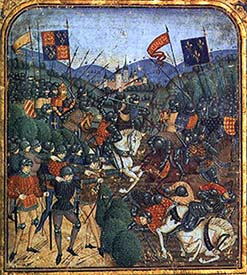 The campaign of 1415, with its brilliant conclusion at Agincourt (October 25), was only the first step. Two years of patient preparation followed. The command of the sea was secured by driving the Genoese allies of the French out of the Channel. A successful diplomacy detached the emperor Sigismund from France, and by the Treaty of Canterbury paved the way to end the schism in the Church. So in 1417 the war was renewed on a larger scale. Lower Normandy was quickly conquered, Rouen cut off from Paris and besieged. The French were paralysed by the disputes of Burgundians and Armagnacs. Henry skilfully played them off one against the other, without relaxing his warlike energy.
The campaign of 1415, with its brilliant conclusion at Agincourt (October 25), was only the first step. Two years of patient preparation followed. The command of the sea was secured by driving the Genoese allies of the French out of the Channel. A successful diplomacy detached the emperor Sigismund from France, and by the Treaty of Canterbury paved the way to end the schism in the Church. So in 1417 the war was renewed on a larger scale. Lower Normandy was quickly conquered, Rouen cut off from Paris and besieged. The French were paralysed by the disputes of Burgundians and Armagnacs. Henry skilfully played them off one against the other, without relaxing his warlike energy.
 In January 1419 Rouen fell. By August the English were outside the walls of Paris. The intrigues of the French parties culminated in the assassination of John of Burgundy by the dauphin's partisans at Montereau (September 10, 1419). Philip, the new duke, and the French court threw themselves into Henry's arms. After six months' negotiation Henry was by the Treaty of Troyes recognized as heir and regent of France, and on the 2nd of June 1420 marriedCatherine, the king's daughter. He was now at the height of his power. His eventual success in France seemed certain.
In January 1419 Rouen fell. By August the English were outside the walls of Paris. The intrigues of the French parties culminated in the assassination of John of Burgundy by the dauphin's partisans at Montereau (September 10, 1419). Philip, the new duke, and the French court threw themselves into Henry's arms. After six months' negotiation Henry was by the Treaty of Troyes recognized as heir and regent of France, and on the 2nd of June 1420 marriedCatherine, the king's daughter. He was now at the height of his power. His eventual success in France seemed certain.
He shared with Sigismund the credit of having ended the Great Schism by obtaining the election of Pope Martin V. All the states of western Europe were being brought within the web of his diplomacy. The headship of Christendom was in his grasp, and schemes for a new crusade began to take shape. He actually sent an envoy to collect information in the East; but his plans were cut short by death. A visit to England in 1421 was interrupted by the defeat of Clarence at Bauge. The hardships of the longer winter siege of Meaux broke down his health, and he died at Bois de Vincennes on the 31st of August 1422.
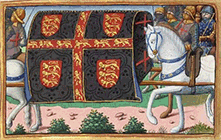 Henry's last words were a wish that he might live to rebuild the walls of Jerusalem. They are significant. His ideal was founded consciously on the models of Arthur and Godfrey as national king and leader of Christendom. So he is the typical medieval hero. For that very reason his schemes were doomed to end in disaster, since the time was come for a new departure. Yet he was not reactionary. His policy was constructive: a firm central government supported by parliament; church reform on conservative lines; commercial development; and the maintenance of national prestige. His aims in some respects anticipated those of his Tudor successors, but he would have accomplished them on medieval lines as a constitutional ruler. His success was due to the power of his personality. He could train able lieutenants, but at his death there was no one who could take his place as leader. War, diplomacy and civil administration were all dependent on his guidance. His dazzling achievements as a general have obscured his more sober qualities as a ruler, and even the sound strategy, with which he aimed to be master of the narrow seas. If he was not the founder of the English navy he was one of the first to realize its true importance.
Henry's last words were a wish that he might live to rebuild the walls of Jerusalem. They are significant. His ideal was founded consciously on the models of Arthur and Godfrey as national king and leader of Christendom. So he is the typical medieval hero. For that very reason his schemes were doomed to end in disaster, since the time was come for a new departure. Yet he was not reactionary. His policy was constructive: a firm central government supported by parliament; church reform on conservative lines; commercial development; and the maintenance of national prestige. His aims in some respects anticipated those of his Tudor successors, but he would have accomplished them on medieval lines as a constitutional ruler. His success was due to the power of his personality. He could train able lieutenants, but at his death there was no one who could take his place as leader. War, diplomacy and civil administration were all dependent on his guidance. His dazzling achievements as a general have obscured his more sober qualities as a ruler, and even the sound strategy, with which he aimed to be master of the narrow seas. If he was not the founder of the English navy he was one of the first to realize its true importance.
Henry had so high a sense of his own rights that he was merciless to disloyalty. But he was scrupulous of the rights of others, and it was his eager desire to further the cause of justice that impressed his French contemporaries. He has been charged with cruelty as a religious persecutor; but in fact he had as prince opposed the harsh policy of Archbishop Arundel, and as king sanctioned a more moderate course. Lollard executions during his reign had more often a political than a religious reason. To be just with sternness was in his eyes a duty. So in his warfare, though he kept strict discipline and allowed no wanton violence, he treated severely all who had in his opinion transgressed. In his personal conduct he was chaste, temperate and sincerely pious. He delighted in sport and all manly exercises. At the same time he was cultured, with a taste for literature, art and music. Henry lies buried in Westminster Abbey. His tomb was stripped of its splendid adornment during the Reformation.
(C. L. Kingsford)
Next year the Lancastrian revolution forced Henry into precocious prominence as heir to the throne. From October 1400 the administration of Wales was conducted in his name; less than three years later he was in actual command of the English forces and fought against the Perciesat Shrewsbury. The Welsh revolt absorbed his energies till 1408. Then through the king's ill-health he began to take a wider share in politics. From January 1410, helped by his unclesHenry Beaufort and Thomas Beaufort, he had practical control of the government. Both in foreign and domestic policy he differed from the king, who in November 1411 discharged the prince from the council.
The quarrel of father and son was political only, though it is probable that the Beauforts had discussed the abdication of King Henry IV, and their opponents certainly endeavoured to defame the prince. It may be that to political enmity the tradition of Henry's riotous youth, immortalized by Shakespeare, is partly due. To that tradition Henry's strenuous life in war and politics is a sufficient general contradiction. The most famous incident, his quarrel with the chief justice, has no contemporary authority and was first related by Sir Thomas Elyot in 1531. The story of Falstaff originated partly in Henry's early friendship for Oldcastle. That friendship, and the prince's political opposition to Archbishop Arundel, perhaps encouraged Lollard hopes. If so, their disappointment may account for the statements of ecclesiastical writers, like Walsingham, that Henry on becoming king was changed suddenly into a new man.
 Henry succeeded his father on the 20th of March 1413. With no past to embarrass him, and with no dangerous rivals, his practical experience had full scope. He had to deal with three main problems — the restoration of domestic peace, the healing of schism in the Church and the recovery of English prestige in Europe. Henry grasped them all together, and gradually built upon them a yet wider policy. From the first he made it clear that he would rule England as the head of a united nation, and that past differences were to be forgotten.Richard II was honourably reinterred; the youngMortimer was taken into favour; the heirs of those who had suffered in the last reign were restored gradually to their titles and estates. With Oldcastle Henry used his personal influence in vain, and the gravest domestic danger was Lollard discontent. But the king's firmness nipped the movement in the bud (Jan. 1414), and made his own position as ruler secure. Save for the abortive Scrope and Cambridge plot in favour of Mortimer in July 1415, the rest of his reign was free from serious trouble at home. Henry could now turn his attention to foreign affairs.
Henry succeeded his father on the 20th of March 1413. With no past to embarrass him, and with no dangerous rivals, his practical experience had full scope. He had to deal with three main problems — the restoration of domestic peace, the healing of schism in the Church and the recovery of English prestige in Europe. Henry grasped them all together, and gradually built upon them a yet wider policy. From the first he made it clear that he would rule England as the head of a united nation, and that past differences were to be forgotten.Richard II was honourably reinterred; the youngMortimer was taken into favour; the heirs of those who had suffered in the last reign were restored gradually to their titles and estates. With Oldcastle Henry used his personal influence in vain, and the gravest domestic danger was Lollard discontent. But the king's firmness nipped the movement in the bud (Jan. 1414), and made his own position as ruler secure. Save for the abortive Scrope and Cambridge plot in favour of Mortimer in July 1415, the rest of his reign was free from serious trouble at home. Henry could now turn his attention to foreign affairs.A writer of the next generation was the first to allege that Henry was encouraged by ecclesiastical statesmen to enter on the French war as a means of diverting attention from home troubles. For this story there is no foundation. The restoration of domestic peace was the king's first care, and until it was assured he could not embark on any wider enterprise abroad. Nor was that enterprise one of idle conquest. Old commercial disputes and the support which the French had lent to Glendower gave a sufficient excuse for war, whilst the disordered state of France afforded no security for peace. Henry may have regarded the assertion of his own claims as part of his kingly duty, but in any case a permanent settlement of the national quarrel was essential to the success of his world policy.
 The campaign of 1415, with its brilliant conclusion at Agincourt (October 25), was only the first step. Two years of patient preparation followed. The command of the sea was secured by driving the Genoese allies of the French out of the Channel. A successful diplomacy detached the emperor Sigismund from France, and by the Treaty of Canterbury paved the way to end the schism in the Church. So in 1417 the war was renewed on a larger scale. Lower Normandy was quickly conquered, Rouen cut off from Paris and besieged. The French were paralysed by the disputes of Burgundians and Armagnacs. Henry skilfully played them off one against the other, without relaxing his warlike energy.
The campaign of 1415, with its brilliant conclusion at Agincourt (October 25), was only the first step. Two years of patient preparation followed. The command of the sea was secured by driving the Genoese allies of the French out of the Channel. A successful diplomacy detached the emperor Sigismund from France, and by the Treaty of Canterbury paved the way to end the schism in the Church. So in 1417 the war was renewed on a larger scale. Lower Normandy was quickly conquered, Rouen cut off from Paris and besieged. The French were paralysed by the disputes of Burgundians and Armagnacs. Henry skilfully played them off one against the other, without relaxing his warlike energy. In January 1419 Rouen fell. By August the English were outside the walls of Paris. The intrigues of the French parties culminated in the assassination of John of Burgundy by the dauphin's partisans at Montereau (September 10, 1419). Philip, the new duke, and the French court threw themselves into Henry's arms. After six months' negotiation Henry was by the Treaty of Troyes recognized as heir and regent of France, and on the 2nd of June 1420 marriedCatherine, the king's daughter. He was now at the height of his power. His eventual success in France seemed certain.
In January 1419 Rouen fell. By August the English were outside the walls of Paris. The intrigues of the French parties culminated in the assassination of John of Burgundy by the dauphin's partisans at Montereau (September 10, 1419). Philip, the new duke, and the French court threw themselves into Henry's arms. After six months' negotiation Henry was by the Treaty of Troyes recognized as heir and regent of France, and on the 2nd of June 1420 marriedCatherine, the king's daughter. He was now at the height of his power. His eventual success in France seemed certain.He shared with Sigismund the credit of having ended the Great Schism by obtaining the election of Pope Martin V. All the states of western Europe were being brought within the web of his diplomacy. The headship of Christendom was in his grasp, and schemes for a new crusade began to take shape. He actually sent an envoy to collect information in the East; but his plans were cut short by death. A visit to England in 1421 was interrupted by the defeat of Clarence at Bauge. The hardships of the longer winter siege of Meaux broke down his health, and he died at Bois de Vincennes on the 31st of August 1422.
 Henry's last words were a wish that he might live to rebuild the walls of Jerusalem. They are significant. His ideal was founded consciously on the models of Arthur and Godfrey as national king and leader of Christendom. So he is the typical medieval hero. For that very reason his schemes were doomed to end in disaster, since the time was come for a new departure. Yet he was not reactionary. His policy was constructive: a firm central government supported by parliament; church reform on conservative lines; commercial development; and the maintenance of national prestige. His aims in some respects anticipated those of his Tudor successors, but he would have accomplished them on medieval lines as a constitutional ruler. His success was due to the power of his personality. He could train able lieutenants, but at his death there was no one who could take his place as leader. War, diplomacy and civil administration were all dependent on his guidance. His dazzling achievements as a general have obscured his more sober qualities as a ruler, and even the sound strategy, with which he aimed to be master of the narrow seas. If he was not the founder of the English navy he was one of the first to realize its true importance.
Henry's last words were a wish that he might live to rebuild the walls of Jerusalem. They are significant. His ideal was founded consciously on the models of Arthur and Godfrey as national king and leader of Christendom. So he is the typical medieval hero. For that very reason his schemes were doomed to end in disaster, since the time was come for a new departure. Yet he was not reactionary. His policy was constructive: a firm central government supported by parliament; church reform on conservative lines; commercial development; and the maintenance of national prestige. His aims in some respects anticipated those of his Tudor successors, but he would have accomplished them on medieval lines as a constitutional ruler. His success was due to the power of his personality. He could train able lieutenants, but at his death there was no one who could take his place as leader. War, diplomacy and civil administration were all dependent on his guidance. His dazzling achievements as a general have obscured his more sober qualities as a ruler, and even the sound strategy, with which he aimed to be master of the narrow seas. If he was not the founder of the English navy he was one of the first to realize its true importance.Henry had so high a sense of his own rights that he was merciless to disloyalty. But he was scrupulous of the rights of others, and it was his eager desire to further the cause of justice that impressed his French contemporaries. He has been charged with cruelty as a religious persecutor; but in fact he had as prince opposed the harsh policy of Archbishop Arundel, and as king sanctioned a more moderate course. Lollard executions during his reign had more often a political than a religious reason. To be just with sternness was in his eyes a duty. So in his warfare, though he kept strict discipline and allowed no wanton violence, he treated severely all who had in his opinion transgressed. In his personal conduct he was chaste, temperate and sincerely pious. He delighted in sport and all manly exercises. At the same time he was cultured, with a taste for literature, art and music. Henry lies buried in Westminster Abbey. His tomb was stripped of its splendid adornment during the Reformation.
(C. L. Kingsford)
Excerpted from:
Encyclopedia Britannica, 11th Ed. Vol XIII.
Cambridge: Cambridge University Press, 1910. 278.
No comments:
Post a Comment